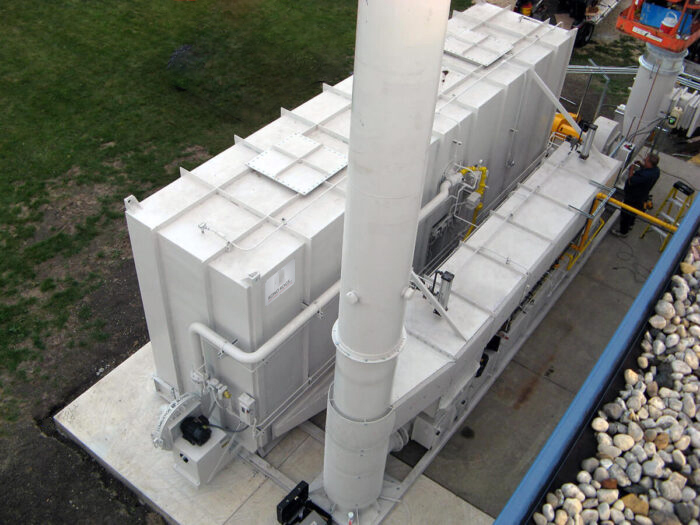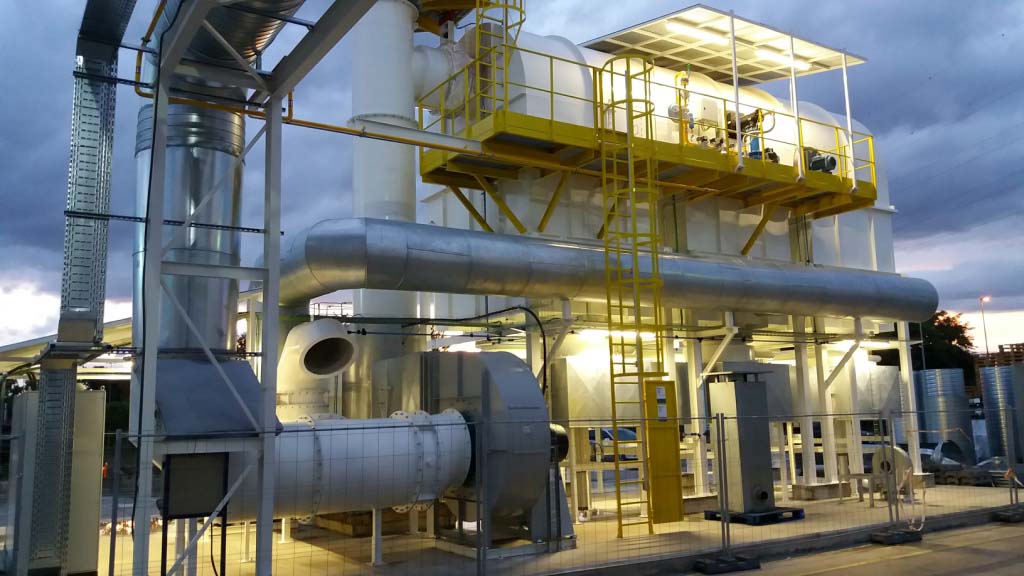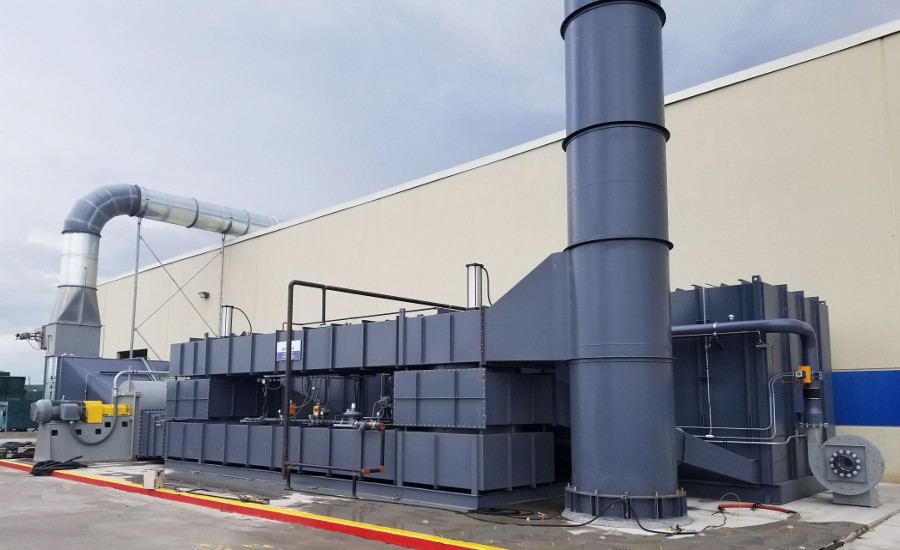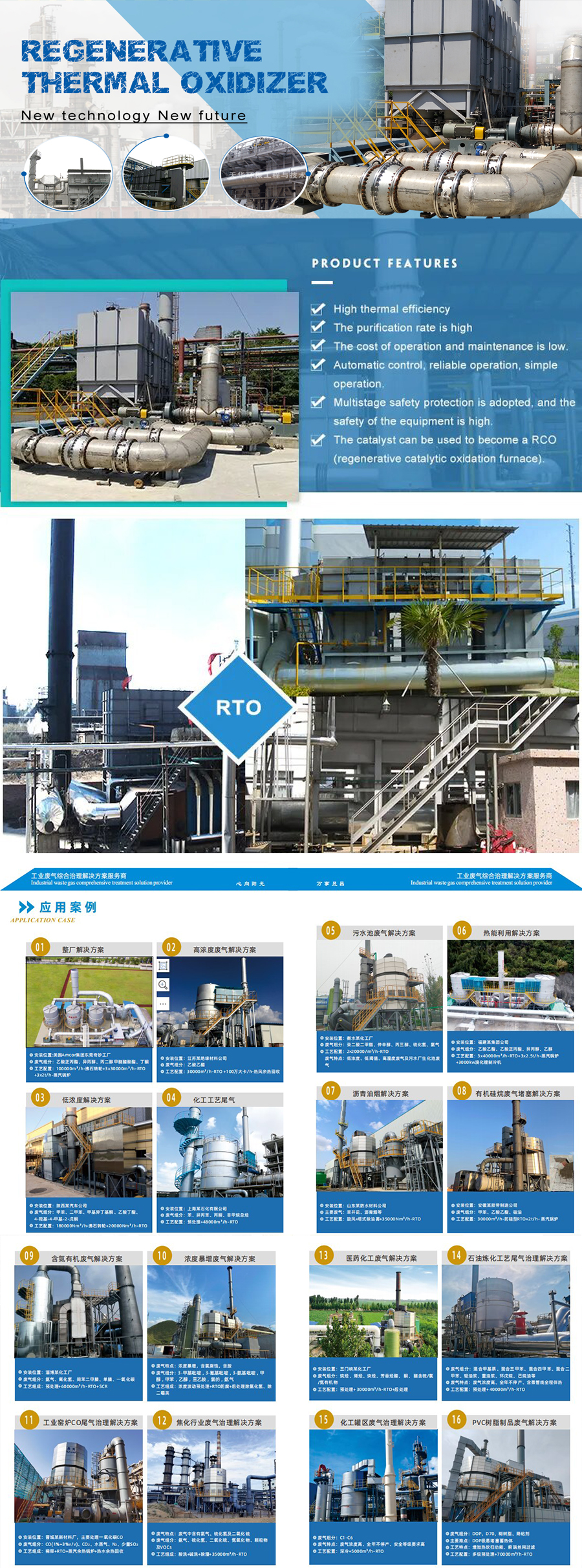Maklumat Asas.
Model NO.
RTO yang menakjubkan
taip
Insinerator
Penyelenggaraan Rendah
100
Operasi Mudah
100
Penjimatan Tenaga
100
Kecekapan Tinggi
100
Tanda dagangan
Bjamazing
Pakej Pengangkutan
Luar negara
Spesifikasi
111
asal usul
China
Kod HS
2221111
Penerangan Produk
RTO
Pengoksida Terma Penjanaan Semula
Compared with traditional catalytic combustion, direct thermal oxidizer, RTO has the merits of high heating efficiency, low operation cost, and the ability to treat large flux low concentration waste gas. When VOCs concentration is high, secondary heat recycle can be realized, which will greatly reduce the operation cost. Because RTO can preheat the waste gas by levels through ceramic heat accumulator, which could make the waste gas to be completely heated and cracked with no dead corner(treatment efficiency>99%),which reduce the NOX in the Exhausting gas, if the VOC density >1500mg/Nm3, when the waste gas reach cracking area, it has been heated up to cracking temperature by heat accumulator, the burner will be closed under this condition.
RTO can be devided into chamber type and rotary type according to difference operation mode. Rotary type RTO has advantages in system pressure, temperature stability, investment amount, etc
| jenis RTO | Kecekapan | Perubahan tekanan (mmAq) | Saiz | (max)Treatment volume | |
| Kecekapan rawatan | Kecekapan kitar semula haba | ||||
| RTO jenis putar | 99 % | 97 % | 0-4 | kecil (1 time) | 50000Nm3/h |
| RTO jenis tiga ruang | 99 % | 97 % | 0-10 | besar (1.5times) | 100000Nm3/h |
| RTO jenis dua ruang | 95 % | 95 % | 0-20 | tengah (1.2times) | 100000Nm3/h |
Regenerative Thermal Oxidizer, Regenerative Thermal Oxidizer, Regenerative Thermal Oxidizer, Thermal Oxidizer, Thermal Oxidizer, Thermal Oxidizer, oxidizer, oxidizer, oxidizer, incinerator, incinerator, incinerator, waste gas treatment, waste gas treatment, waste gas treatment, VOC treatment, VOC treatment, VOC treatment, RTO, RTO, RTO, Rotary RTO, Rotary RTO, Rotary RTO, Chamber RTO, Chamber RTO, Chamber RTO
Alamat: tingkat 8, E1, bangunan Pinwei, jalan Dishengxi, Yizhuang, ZheJiang, China
Jenis Perniagaan: Pengeluar/Kilang, Syarikat Perdagangan
Julat Perniagaan: Elektrik & Elektronik, Peralatan & Komponen Industri, Jentera Pembuatan & Pemprosesan, Metalurgi, Mineral & Tenaga
Pensijilan Sistem Pengurusan: ISO 9001, ISO 14001
Produk Utama: Rto, Talian Salutan Warna, Talian Galvanisasi, Pisau Udara, Alat Ganti untuk Talian Pemprosesan, Coater, Peralatan Bebas, Gulung Sink, Projek Ubahsuai, Blower
Pengenalan Syarikat: ZheJiang Amazing Science & Technology Co., Ltd ialah sebuah syarikat berteknologi tinggi yang berkembang maju, terletak di ZheJiang Economic and Technological Development Area(BDA). Berpegang kepada konsep Realistik, Inovatif, Fokus dan Cekap, syarikat kami menyediakan perkhidmatan terutamanya dalam industri rawatan gas sisa (VOC) dan peralatan metalurgi China dan juga seluruh dunia. Kami mempunyai teknologi canggih dan pengalaman yang kaya dalam projek rawatan gas buangan VOC, yang rujukannya telah berjaya digunakan untuk industri salutan, getah, elektronik, percetakan, dll. Kami juga mempunyai pengumpulan teknologi selama bertahun-tahun dalam penyelidikan dan pembuatan flat talian pemprosesan keluli, dan mempunyai hampir 100 contoh aplikasi.
Syarikat kami menumpukan pada penyelidikan, reka bentuk, pengilangan, pemasangan dan pentauliahan sistem rawatan gas sisa organik VOC dan projek merombak dan mengemas kini untuk penjimatan tenaga dan perlindungan alam sekitar barisan pemprosesan keluli rata. Kami boleh menyediakan pelanggan penyelesaian lengkap untuk perlindungan alam sekitar, penjimatan tenaga, peningkatan kualiti produk dan aspek lain.
Kami juga terlibat dalam pelbagai alat ganti dan peralatan bebas untuk garis salutan warna, garis galvanizing, garis penjerukan, seperti penggelek, pengganding, penukar haba, recuperator, pisau udara, peniup, pengimpal, penyamara ketegangan, pas kulit, sambungan pengembangan, ricih, penyambung , penjahit, penunu, tiub berseri, motor gear, pengurang, dsb.

What is the cost of installing a regenerative thermal oxidizer?
The cost of installing a regenerative thermal oxidizer (RTO) can vary significantly depending on several factors. These factors include the size and capacity of the RTO, the specific requirements of the application, site conditions, and any additional customization or engineering needed. However, it’s important to note that RTOs are generally considered a significant capital investment due to their complex design and high-performance capabilities.
Here are some cost considerations associated with installing an RTO:
- RTO Size and Capacity: The size and capacity of the RTO, typically measured in terms of exhaust flow rate and pollutant concentration, are important cost factors. Larger RTOs capable of handling higher exhaust volumes and pollutant concentrations generally have higher upfront costs compared to smaller units.
- Engineering and Customization: The engineering and customization requirements for integrating the RTO into the existing industrial process can impact the installation cost. This includes factors such as ductwork modifications, electrical connections, and any necessary process integration to ensure proper functioning of the RTO within the overall system.
- Site Preparation: The site where the RTO will be installed may require preparation to accommodate the equipment. This can involve constructing foundations, providing adequate space for the RTO and associated components, and ensuring proper access for installation and maintenance.
- Auxiliary Systems and Equipment: In addition to the RTO itself, there may be auxiliary systems and equipment required for effective operation. This can include pre-treatment systems, such as scrubbers or filters, heat recovery units, monitoring and control systems, and stack emissions monitoring equipment. The cost of these additional components should be considered in the overall installation cost.
- Installation Labor and Equipment: The cost of labor and equipment required for the installation process, including crane services and specialized contractors, should be factored into the overall cost. The complexity of the installation and any specific site challenges can influence these costs.
- Permits and Compliance: Obtaining necessary permits and complying with regulatory requirements can involve additional costs. This includes fees for environmental permits, engineering studies, emissions testing, and compliance documentation.
Due to the many variables involved, it is challenging to provide a specific cost range for installing an RTO. It is recommended to consult with reputable RTO manufacturers or engineering firms, who can assess the specific requirements of the application and provide detailed cost estimates based on the project scope.

Bolehkah pengoksida terma regeneratif digunakan untuk merawat pelepasan daripada proses farmaseutikal?
Ya, pengoksida terma regeneratif (RTO) boleh digunakan dengan berkesan untuk merawat pelepasan daripada proses farmaseutikal. Proses pembuatan farmaseutikal selalunya menghasilkan sebatian organik meruap (VOC) dan bahan pencemar udara berbahaya (HAP) yang perlu dikawal untuk mematuhi peraturan alam sekitar dan memastikan kualiti udara. Berikut adalah beberapa perkara penting mengenai penggunaan RTO untuk merawat pelepasan daripada proses farmaseutikal:
- Kawalan pelepasan: RTO direka untuk mencapai kecekapan pemusnahan yang tinggi untuk VOC dan HAP. Bahan pencemar ini teroksida dalam RTO pada suhu tinggi, biasanya melebihi kecekapan 95%, menukarkannya kepada karbon dioksida (CO2) dan wap air. Ini memastikan kawalan yang berkesan dan pengurangan pelepasan daripada proses farmaseutikal.
- Keserasian Proses: RTO boleh disepadukan ke dalam sistem ekzos pelbagai proses farmaseutikal, menangkap dan merawat pelepasan sebelum ia dilepaskan ke atmosfera. RTO biasanya disambungkan ke peralatan proses atau timbunan ekzos, membenarkan udara yang sarat VOC melalui pengoksida untuk rawatan.
- Fleksibiliti: RTO menawarkan fleksibiliti dalam mengendalikan pelbagai keadaan operasi dan bahan pencemar. Proses farmaseutikal boleh berbeza dari segi kadar aliran, suhu dan komposisi pelepasan. RTO direka bentuk untuk menampung variasi ini dan menyediakan rawatan yang berkesan walaupun dalam keadaan yang berubah-ubah.
- Pemulihan Haba: RTO menggabungkan sistem pertukaran haba yang membolehkan pemulihan dan penggunaan semula tenaga haba. Penukar haba dalam RTO menangkap haba daripada gas ekzos yang keluar dan memindahkannya ke aliran udara atau gas proses masuk. Proses pemulihan haba ini meningkatkan kecekapan tenaga keseluruhan sistem dan mengurangkan keperluan untuk penggunaan bahan api tambahan.
- Pematuhan dengan Peraturan: Proses farmaseutikal tertakluk kepada keperluan kawal selia untuk kawalan kualiti udara dan pelepasan. RTO mampu mencapai kecekapan pemusnahan yang diperlukan dan boleh membantu pengeluar farmaseutikal mematuhi peraturan alam sekitar. Penggunaan RTO menunjukkan komitmen terhadap amalan mampan dan pengurusan pelepasan udara yang bertanggungjawab.
Adalah penting untuk ambil perhatian bahawa reka bentuk dan konfigurasi khusus RTO, serta ciri-ciri pelepasan farmaseutikal, harus dipertimbangkan semasa melaksanakan RTO untuk aplikasi tertentu. Berunding dengan jurutera berpengalaman atau pengilang RTO boleh memberikan pandangan berharga tentang keperluan saiz, penyepaduan dan prestasi yang sesuai untuk merawat pelepasan daripada proses farmaseutikal.
Ringkasnya, RTO ialah teknologi yang sesuai dan berkesan untuk merawat pelepasan daripada proses farmaseutikal, menyediakan kecekapan pemusnahan yang tinggi, keserasian dengan pelbagai proses, fleksibiliti dalam mengendalikan keadaan operasi, pemulihan haba, dan pematuhan kepada peraturan alam sekitar.

Regenerative Thermal Oxidizer vs. Thermal Oxidizer
When comparing a regenerative thermal oxidizer (RTO) to a conventional thermal oxidizer, there are several key differences to consider:
1. Operation:
A regenerative thermal oxidizer operates using a cyclical process that involves heat recovery, while a thermal oxidizer typically operates in a continuous mode without heat recovery.
2. Heat Recovery:
One of the primary distinctions between the two systems is the heat recovery mechanism. An RTO utilizes heat exchanger beds filled with ceramic media or structured packing to recover heat from the outgoing gases and preheat the incoming gases, resulting in energy savings. In contrast, a thermal oxidizer does not incorporate heat recovery, leading to higher energy consumption.
3. Efficiency:
RTOs are known for their high destruction efficiency, typically above 95%, which enables effective removal of volatile organic compounds (VOCs) and other pollutants. Thermal oxidizers, on the other hand, may have slightly lower destruction efficiencies depending on the specific design and operating conditions.
4. Energy Consumption:
Due to the heat recovery mechanism, RTOs generally require less energy for operation compared to thermal oxidizers. The preheating of incoming gases in an RTO reduces the fuel consumption required for combustion, making it more energy-efficient.
5. Cost-effectiveness:
While the initial capital investment for an RTO can be higher than that of a thermal oxidizer due to the heat recovery components, the long-term operational cost savings through energy recovery and higher destruction efficiencies make RTOs a cost-effective solution over the lifespan of the system.
6. Environmental Compliance:
Both RTOs and thermal oxidizers are designed to meet emissions regulations and help industries comply with air quality standards and permits. However, RTOs typically offer higher destruction efficiencies, which can enhance environmental compliance.
7. Versatility:
RTOs and thermal oxidizers are both versatile in terms of handling a wide range of process exhaust volumes and pollutant concentrations. However, RTOs are often preferred for applications where high destruction efficiencies and energy recovery are critical.
Overall, the key distinctions between a regenerative thermal oxidizer and a thermal oxidizer lie in the heat recovery mechanism, energy consumption, efficiency, and cost-effectiveness. RTOs offer superior energy recovery and higher destruction efficiencies, making them an attractive option for industries that prioritize energy efficiency and environmental compliance.

editor by CX 2023-10-15
